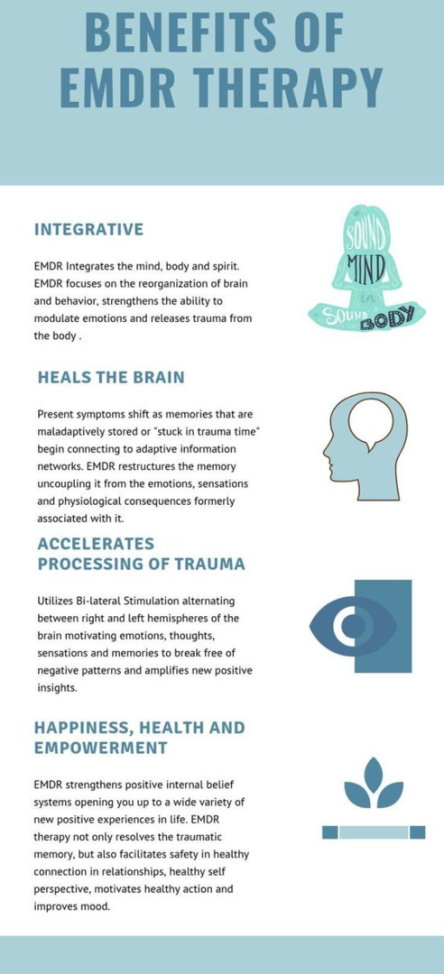
What is EMDR?
Eye Movement Desensitization and Reprocessing (EMDR) therapy is an interactive psychotherapy technique used to relieve psychological stress. It is an effective treatment for trauma and post-traumatic stress disorder (PTSD).
During EMDR therapy sessions, you relive traumatic or triggering experiences in brief doses while the therapist directs your eye movements.
EMDR is thought to be effective because recalling distressing events is often less emotionally upsetting when your attention is diverted. This allows you to be exposed to the memories or thoughts without having a strong psychological response.
Over time, this technique is believed to lessen the impact that the memories or thoughts have on you.
People who are dealing with traumatic memories and those who have PTSD are thought to benefit the most from EMDR therapy.
It’s thought to be particularly effective for those who struggle to talk about their past experiences.
Although there is not sufficient research to prove its effectiveness in these areas, EMDR therapy is also being used to treat:
EMDR therapy is broken down into eight different phases, so you’ll need to attend multiple sessions. Treatment usually takes about 12 separate sessions.
Phase 1: History and treatment planning
Your therapist will first review your history and decide where you are in the treatment process. This evaluation phase also includes talking about your trauma and identifying potential traumatic memories to treat specifically.
Phase 2: Preparation
Your therapist will then help you learn several different ways to cope with the emotional or psychological stress you’re experiencing.
Stress management techniques such as deep breathing and mindfulness may be used.
Phase 3: Assessment
During the third phase of EMDR treatment, your therapist will identify the specific memories that will be targeted and all the associated components (such as the physical sensations that are stimulated when you concentrate on an event) for each target memory.
Phases 4-7: Treatment
Your therapist will then begin using EMDR therapy techniques to treat your targeted memories. During these sessions, you will be asked to focus on a negative thought, memory, or image.
Your therapist will simultaneously have you do specific eye movements. The bilateral stimulation may also include taps or other movements mixed in, depending on your case.
After the bilateral stimulation, your therapist will ask you to let your mind go blank and notice the thoughts and feelings you’re having spontaneously. After you identify these thoughts, your therapist may have you refocus on that traumatic memory, or move on to another.
If you become distressed, your therapist will help bring you back to the present before moving on to another traumatic memory. Over time, the distress over particular thoughts, images, or memories should start to fade.
Phase 8: Evaluation
In the final phase, you’ll be asked to evaluate your progress after these sessions. Your therapist will do the same.--Healthline.com
How Do I Know If I'm Ready for EMDR?
In
terms of your relationship with your therapist:
Do you feel safe if your therapist learns that you feel upset?
Do you feel safe disagreeing with them, and saying things that risk disapproval?
When distressed, is your therapist’s voice something that you consider
comforting?
If your therapist asked you to do something that was uncomfortable to imagine, would you be willing to try it and see if it works?
In
terms of trigger coping:
While triggered, are you able to receive good advice from a trusted source?
While triggered, are you able to refrain from acting on dangerous impulses?
If you are in a position to get value out of breaking down barriers (if your ‘good days’ are good), then it’s OK if your trigger-coping is imperfect. If, on the other hand, you are afraid that you’ll immediately get physically violent if triggered, then that fear needs to be addressed. If you experience frightening suicidal ideation or impulses to self-harm (if you don’t feel able to restrain those things), then you need to have safety mechanisms in place to prevent those outcomes from taking place.
In terms of getting value out of breaking down barriers:
At your best, are you able to receive kindness?
At your best, are you able to offer kindness to others?
At your best, are you able to acknowledge other perspectives without feeling
threatened?
EMDR breaks down the barriers between the ‘apparently normal part(s)’ (ANP) and the ‘emotional part(s)’ (EP). If your best ANP doesn’t have a reservoir of kindness that it can
access, and an ability to acknowledge other perspectives, then you may be better off building it up in isolation before connecting it to the bits that are really
suffering.
You’ll have some idea of what you’re going to find, what you’re going to connect to.
It’s OK to be frightened of it. Your therapist will be there and will try to help you get through it. The question is whether you think that the two of you will be able to work together to endure
making the connection, and to get something positive out of it. The questions above are hopefully helpful in making that assessment.-- Argill, N.
If you are ready, contact us


